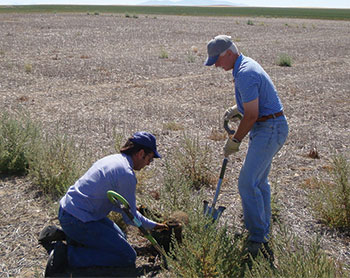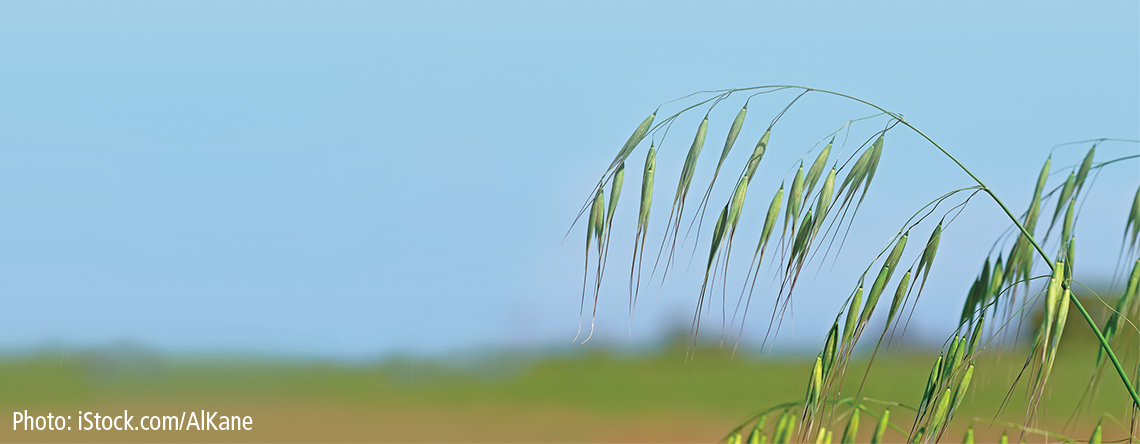Herbicide resistance has been increasing across Canada for the past four decades, with resistant weeds now found on an estimated 38 million acres of cropland in Western Canada.
According to Hugh Beckie, research scientist with Agriculture and Agri-Food Canada (AAFC), the rising percentage of cropland affected by herbicide resistant weeds is showing no signs of slowing down.
Beckie was part of a team that conducted three rounds of prairie weed surveys in 2001-2003, 2007-2009 and 2014-2017. During each period, the team surveyed one of the three Prairie provinces per season. “Across the Prairies, we quickly found that the more we looked, the more resistance we discovered,” he says.
When Saskatchewan was last evaluated in 2015, the team found that 57 per cent of surveyed cropland had weeds that were resistant to one or more herbicide modes of action.
“That is quite a jump from 2009 when it was about 30 per cent. Before that, the first survey done in 2003 had only 10 per cent,” says Beckie. “So, we’ve gone from 10 per cent, to 30 per cent, to now nearly 60 per cent.”
A Matter of Belief
Beckie says herbicide resistance has risen so sharply due in part to the practices producers use to control weeds. He says producers typically don’t proactively manage for resistance, and only change their practices once they have experienced challenges with resistant weeds.
We know that it’s out there, lurking in our stands, we just haven’t experienced an all-out failure yet.
Wendy Leeds, lead agronomist with Sharpe’s Crop Services in Moosomin, Sask., and CAAR’s 2011 Agronomist of the Year, says getting growers on board with managing resistance can be a challenge.
“Herbicide resistance can sometimes be a difficult concept for producers to accept. If they can’t physically see it, they sometimes don’t believe they could have it,” she says. “If they don’t believe in it, they’re not going to plan for it – which is unfortunate.”
Leeds says agronomists must try to change their customers’ minds – which is easier said than done if growers are in denial.
“It’s a realization they need to have, and we just have to keep talking about it,” she says. “Retailers should stay up-to-date on the latest research and present that research to their customers.”
Leeds says it is difficult to estimate how many of her customers have resistance, but she has several confirmed cases, and many cases where resistance is likely to develop.
“We know that it’s out there, lurking in our stands. We just haven’t experienced an all-out failure yet,” she says.
When patches of weeds appear on a field, even after spraying, Leeds and her team actively engage with the grower, monitor the weeds and send samples to a lab for testing.
A Constant Battle
Herbicide resistance can create significant issues for balancing a grower’s short-term needs with long-term viability, something Leeds describes as a “constant battle.”
“Agronomically, you want to present the best options you have. But, you also want to see your customers thriving, not just agronomically, but economically and personally,” she says.
“At the end of the day, our customers need return on investment to pay their bills,” says Leeds. “When you have bills to pay, day in and day out, it’s hard to picture what you will do four or five years down the road when resistance has caused your land value to fall.”
Decreased land value is just one of the many economic consequences Beckie says producers may face if they experience wide-scale resistance.
“You could see significant yield loss, and loss of crop quality. You could double your normal spraying costs,” says Beckie. “And, perhaps most importantly, you could permanently lose some really valuable herbicide tools.”
Keep the weeds guessing as to what’s coming next.
Keep Them Guessing
Leeds and Beckie agree that the most effective strategies to manage resistance include creating more competitive crops and varying practices to slow down weed adaptation.
Beckie says one of the most important actions retailers can help their producers take is diversifying their crop rotations, so they’re not relying on the same herbicide year after year.
“Creating herbicide diversity will prevent the weeds from adapting as quickly,” he says. “Diversifying crop rotations can also help slow resistance by altering the weed life cycle.”
Beckie also recommends mixing two herbicides from different groups together. As long as both herbicides control the weed in question, this can be an effective way to slow down resistance. He also recommends rotating herbicide groups within a single season or across years in a field. “Keep the weeds guessing as to what’s coming next,” he says.
According to Leeds, it is important to use integrated weed management practices and take a variety of actions to control weeds. “Vary your crops, ensure adequate seeding rates and fertility. Really, do anything you can to create a more competitive crop and outcompete the weeds,” she says.
She reiterates that believing the issue is real is the first step for producers when it comes to proactively managing for herbicide resistance.
“Once producers really believe in a problem, they’ll do anything they can to eradicate it. They’ll be open to whatever it takes,” says Leeds. “So just keep having those conversations.”

Hugh Beckie’s Top Ten Best Management Practices for Herbicide Resistance:
- Crop rotation diversity
- Use competitive crops and practices that promote competitiveness
- Pre- and post-herbicide scouting: find out what’s surviving
- Herbicide mixtures/sequences (pre, in-crop and post)
- Herbicide group rotation: avoid back-to-back Group One or Two
- Rotate in-crop, wheat-selective herbicides
- Weed sanitation: field immigration and dispersal
- Field- and site-specific (patch) weed management
- Strategic tillage
- Sound record keeping
Related Articles
- April 2024 issue of CAAR Communicator now available online The April issue of CAAR Communicator "I Think therefore AI AG" should arrive in your mailbox any day now. The issue welcomes new Executive Director Myrna Grahn who began her new role on March 25, 2024. The featur...
- Strategies to recruit top talent Craft tailored compensation packages, offer flexible work arrangements, and create an optimum work environment. By Denise Faguy, Associate Editor Data from the Canadian Agricultural Human Resource Council (CAHRC)...
- Increasing your company’s brand reputation A well-thought-out brand marketing campaign will help you grow and promote your brand. By Andrew Joseph, Editor A company is often only as good as how the customer or consumer perceives it to be. It doesn’t even...
- The world of seed technology: things to know for 2024 With science changing along with the seasons, we look at the world of seed technology, offering a forecast. By Marc Zienkiewicz, Senior Editor of Seed World Group Right now exciting things are on the horizon for ...
- Views, Considerations & Unknowns for 2024 With 2024 upon us, the agriculture trade show and seminar season is now in full swing. By Mitch Rezansoff, Executive Director With 2024 upon us, the agriculture trade show and seminar season is now in full swing....
 How to resolve AdBlock issue?
How to resolve AdBlock issue? 
Join the discussion...
You must be logged in as a CAAR member to comment.
Report
My comments